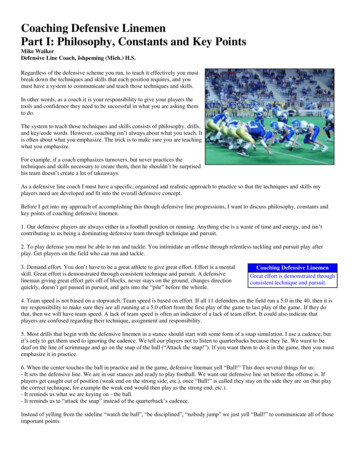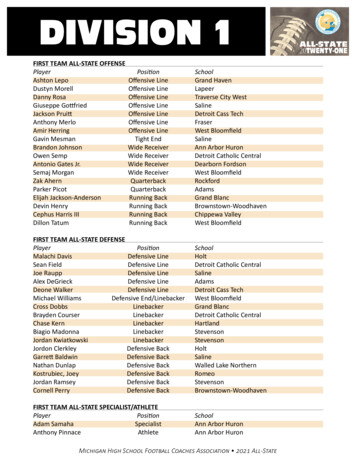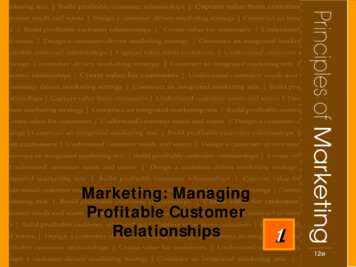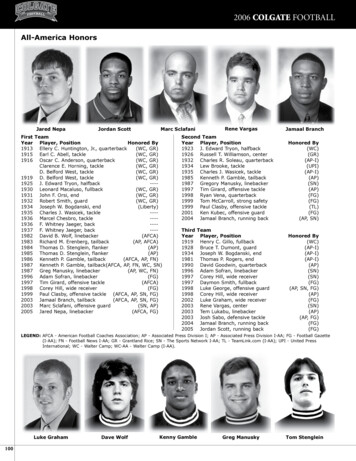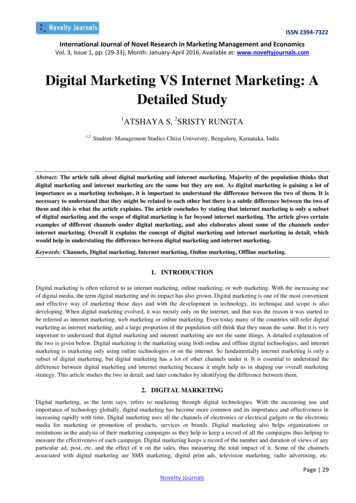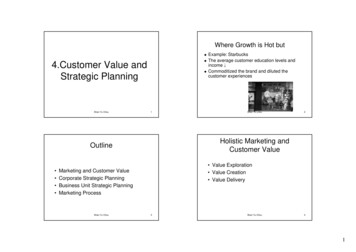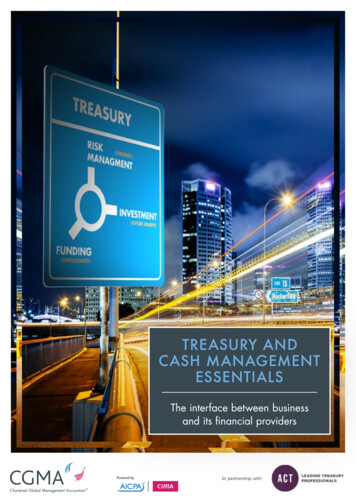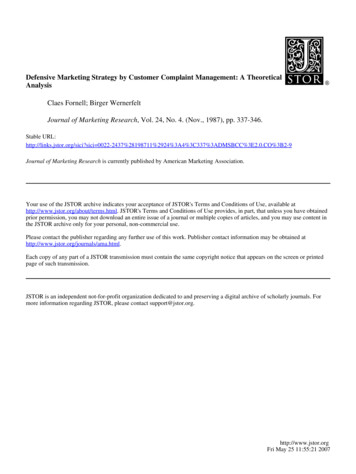
Transcription
Defensive Marketing Strategy by Customer Complaint Management: A TheoreticalAnalysisClaes Fornell; Birger WernerfeltJournal of Marketing Research, Vol. 24, No. 4. (Nov., 1987), pp. 337-346.Stable URL:http://links.jstor.org/sici?sici O%3B2-9Journal of Marketing Research is currently published by American Marketing Association.Your use of the JSTOR archive indicates your acceptance of JSTOR's Terms and Conditions of Use, available athttp://www.jstor.org/about/terms.html. JSTOR's Terms and Conditions of Use provides, in part, that unless you have obtainedprior permission, you may not download an entire issue of a journal or multiple copies of articles, and you may use content inthe JSTOR archive only for your personal, non-commercial use.Please contact the publisher regarding any further use of this work. Publisher contact information may be obtained athttp://www.jstor.org/journals/ama.html.Each copy of any part of a JSTOR transmission must contain the same copyright notice that appears on the screen or printedpage of such transmission.JSTOR is an independent not-for-profit organization dedicated to and preserving a digital archive of scholarly journals. Formore information regarding JSTOR, please contact support@jstor.org.http://www.jstor.orgFri May 25 11:55:21 2007
CLAES FORNELL and BIRGER WERNERFELT*On the basis of Hirschman's exit-voice theory, an economic model of defensivemarketing strategy is developed for complaint management. Though many firmsstrive to reduce the number of customer complaints about their products, this objective is found to be questionable. Instead, analysis suggests complaints from dissatisfied customers should be maximized subject to certain cost restrictions. Theauthors also show that defensive marketing (e.g., complaint management) can lowerthe total marketing expenditure by substantially reducing the cost of offensive marketing (e.g., advertising). The savings in offensive marketing are often high enoughto offset the additional costs associated with compensating complaining customers,even if compensation exceeds the product's profit margin.Defensive Marketing Strategy by CustomerComplaint Management: A TheoreticalAnalysisFirms improve sales and market shares in a variety ofways. Successful marketing strategy basically dependson the f m ' s ability to identify and influence the flowsof customers into and out of its franchise and into andout of the market. These flows consist of (1) additionalcustomer entry to the market, (2) brand shifting or changeof patronage, (3) customer market exit, and (4) changesin purchase frequency. Firms seek to control these fourcustomer flows because they are the ultimate determinants of growth, stagnation, or decline.The marketing literature emphasizes strategies designed to obtain additional customers, encourage brandswitching, and increase purchase frequency. These areoffensive, as opposed to defensive, measures. In the faceof increasing competition and/or maturing industries orshrinking markets, offensive objectives become increasingly difficult to meet. The cost of generating a new customer can substantially exceed the cost of retaining a*Claes Fornell is the Donald C. Cook Professor of Business Adrninistration, Graduate School of Business Administration, University ofMichigan, and Visiting Professor of Marketing, INSEAD, France.Birger Wernerfelt is Associate Professor of Strategy, J . L. KelloggGraduate School of Management, Northwestern University.The authors thank Don Lehmann, John Hauser, and Chris Puto forcomments on a previous version of the article.present customer. Because low growth and highly competitive markets are increasingly common characteristicsof many industries (e.g., automobiles, farm machinery,radio and TV, primary metals, engines and turbines,photographic goods, tobacco products, and clothing, tomention just a few; U.S. Department of Commerce 1986),defensive marketing strategy is becoming more important. Instead of attempting to obtain new customers orencourage brand switching, defensive marketing is concerned with reducing customer exit and brand switching.That is, the objective of defensive marketing strategy isto minimize customer turnover (or, equivalently, tomaximize customer retention) by protecting products andmarkets from competitive inroads.Very little theoretical or empirical research has beendone on defensive marketing, with the exception of workon brand loyalty (Wind 1982). Among the exceptions isthe work by Hauser and Shugan (1983). They developa normative model of how a firm with an establishedbrand should adjust its marketing expenditures to defendits position against the launch of a new competitive brand.Application of the model is discussed by Hauser andGaskin (1984), Hauser (1984), and Shugan (1987). Another interesting approach is presented by Gensch (1984),who segments industrial buyers on the basis of probabilities of switching and loyalty as a first step in determining the allocation of resources to offensive versusJournal of Marketing ResearchVol. XXIV (November 1987), 337-46
JOURNAL OF MARKETING RESEARCH, NOVEMBER 1987defensive marketing. In the popular management literature, Porter (1985) devotes a chapter to defensive strategy.Our approach is similar in spirit to Hauser and Shugan's, but we examine an interplay of both offensive anddefensive marketing in such a way that market share andprofit can not only be maintained, but also increased.Hauser and Shugan define defensive marketing strategyas the reaction of a brand to the launch of a new competitive brand. Our conceptualization of defensive strategy is somewhat more general and does not require newentrants. This distinction may be important because defensive strategy is especially attractive in industries thatare stagnant or shrinking. Under such conditions, an industry is less likely to attract new firm entries. In themodel we develop, the guiding principle is to preventboth current and/or new competitors from taking awaythe f m ' s business.In addition to the literature on defensive strategy, anarea of research in the field of consumer affairs is relevant to our study. Of particular interest are the studiesthat have examined consumer dissatisfaction, complaints, and subsequent purchase behavior. The value ofcomplaints, both as a communication device and as ameans of giving the fm a chance to turn a dissatisfiedcustomer into a satisfied and loyal customer, was analyzed more than 10 years ago (Fornell 1976). A few yearslater, the U.S. Office of Consumer Affairs commissioned a survey of business complaint handling (TARP1979). Its findings confmed those of Fornell-thatcomplaint-handling practices needed upgrading in mostcompanies. TARP also presented consumer data suggesting that complaining customers showed stronger brandloyalty than customers who did not complain and thatloyalty could be strengthened further by the f m ' s complaint handling.The analysis we develop is very different from thatpresented by TARP. We use economic theory and formal analysis to demonstrate how defensive marketing(e.g., retaining dissatisfied customers) can have a substantial impact on a f m ' s market share and profits andalso can lower the cost of offensive marketing. We amplify previous empirical findings (and recommendationsby TARP) by providing a mathematical analysis basedon formal theory.We begin by stating the necessary assumptions aboutconsumer dissatisfaction and subsequent purchase behavior. The theoretical framework;'which comes fromthe economist Albert 0 . Hirschman, then is describedbriefly. Next we turn to the model development. Forsimplicity, our baseline case is a duopoly in which neither firm is actively encouraging complaints from dissatisfied customers. We analyze the effects when onefm decides to use defensive strategy in the form ofcomplaint management and also the effects of the symmetric case when both firms do so. Having laid thegroundwork for the mathematical model in a very simplemarket structure (duopoly), we extend the analysis to then - f m oligopoly and find complaint management can increase a firm's market share as well as reduce its expenditures for offensive marketing. Finally, we illustratethese effects by using published data. We conclude witha discussion of limitations and a summary.BASIC ASSUMPTIONSIt is a truism that the way to retain customers is totreat them well. However, all f m s cannot achieve 100%customer satisfaction for all customers all the time. Therewill always be some customer dissatisfaction due to avariety of causes (including, at least for certain types ofproducts, customer desire for variety). In nongrowthmarkets, competition centers around the (more or less)dissatisfied customers. For the purpose of our analysis,it is sufficient to define dissatisfaction as a state of cognitive/affective discomfort caused by an insufficient return relative to the resources spent by the consumer atany stage of the purchase/consumption process. The resources typically consist of money, time, and energywhereas the return is the utility obtained.The implications from this view of customer dissatisfaction are that (1) satisfaction can be restored by increasing the return to the customer (e.g., by money backor other forms of compensation) and (2) dissatisfactionis a matter of degree and hence does not automaticallycause a buyer to desert a "faltering" seller. Because ofthe risk and cost of switching, the dissatisfied customermay in fact decide to repurchase from the same firm.A fundamental objective of defensive marketing is tomanage customer dissatisfaction in such a manner thatits negative and harmful effects on the firm are minimized. The basic purpose of offensive marketing (innongrowth markets) is to attract competitors' dissatisfiedbuyers. We assume once a buyer has become dissatisfiedwith a brand the loyalty to that brand declines, but theprobability of repurchasing the brand does not go to zero(Schmalensee 1978; Smallwood and Conlisk 1979 makethe same assumption). In particular, we assume consumers make their brand choice decision in two stages.First, if the brand last purchased was satisfactory, theyremain loyal. If it was not satisfactory, they go to a second stage. In our formulation, consumers in the secondstage select among all brands in the market according tothe offensive marketing efforts undertaken by thosebrands. This type of behavior is a consequence of whathas been called "weak dissatisfaction" by Schmalensee(1978) and Smallwood and Conlisk (1979) and facilitates the algebra to follow. An alternative state, "strongdissatisfaction," in which consumers in the second stageselect from all brands except that last purchased, givessimilar results but requires more complicated (though notmore enlightening) analytics.Empirical research (see Fornell 1987; TARP 1979,1986) suggests most buyer complaints have their rootsin some dissatisfaction or problems the buyer experienced while using the product (including problems inhaving products serviced). Apparently such problems are
CUSTOMER COMPLAINT MANAGEMENTfairly seldom caused by product malfunctions or breakdowns or by fraudulent business conduct. In fact, mostempirical studies on the matter suggest buyer grievancestypically can be explained by ignorance, misunderstandings, inflated expectations, or disagreements (Stele 1977).Thus, our assumption that it should be possible to retainat least a fraction of the "weakly dissatisfiedn customersis not without (at least indirect) empirical support.A f m ' s dissatisfied customers may well representcompeting f m s ' only growth opportunity in stagnatingmarkets. Thus, there is always some probability that (1)a buyer will be dissatisfied and (2) consider switchingto another brand ( f m ) whose advertising is designed toattract dissatisfied buyers. This is the starting point ofour analysis. The first step a fm must take to preventadverse brand-switching or customer exit is to identifythe buyers who are dissatisfied. The second step is persuading those buyers to remain loyal. Our analysis showsthat maximizing the number of complaints from dissatisfied customers (subject to certain cost constraints) is inthe best interest of the firm. This finding appears to becontrary to common business practice (see Fornell andWestbrook 1984). Our analysis further shows that thefm often is well advised to compensate dissatisfiedbuyers with amounts exceeding the product's contribution to overhead. Finally, we show that by attracting andresolving complaints, the fm can defend against competitive advertising and lower the cost of offensive marketing without losing market share.HIRSCHMAN'S EXIT-VOICE THEORYA useful theoretical framework that is the foundationfor our normative model is provided by Hirschman (1970).His exit-voice theory pertains to situations in which aclient of an organization, in our context a customer of abusiness fm. becomes dissatisfied with the services orproducts provided by the organization. According toHirschman, management discovers its failure to providesatisfaction via two feedback mechanisms, exit and voice.Exit implies that the customer stops buying from the fm.Voice is the customer's complaint that expresses the dissatisfaction directly to the firm.According to traditional microeconomic theory, exit isa powerful corrective market mechanism. When a fmfails to meet consumer expectations, it is punished bycustomer withdrawal or a shift in buyer patronage. Theefficacy of competition is essential to the idea of exit asa means for affecting the f m ' s decision making; exitcauses shifts in revenue among competing firms and setsmarket forces in motion such that faltering f m s musteither improve or face eventual elimination from themarket. Thus, the successful business f m is highly sensitive to customer exit.Whereas exit is an economic action, voice is more apolitical phenomenon. The voicing customer does notrely on the market to improve his or her position. Instead, voice is an attempt by the customer to change thepractices, policies, or offerings of the firm and to seeksome form of remedy. In Hirschman's terms, exit is essentially an escape from an objectionable state of affairsand voice is an attempt to accomplish change. However,for competitive business f m s , exit is clearly the dominant customer response to dissatisfaction. Voice is anunderdeveloped mechanism, particularly for packagedgoods. Only one of 50 dissatisfied packaged goods customers has been reported to voice (Nielsen 1981).Hirschman was concerned with the optimal mix of exitand voice, but concluded that an optimum does not existfor there is always a deficiency in either exit or voice.Hence it is unlikely that one could specify an efficientmix of the two that would be stable over time. In otherwords, management will strive to weaken the weaponstheir customers wield, be they exit or voice. For example, competitive f m s that are normally sensitive toexit can learn to play a cooperative game in which theytake each other's dissatisfied customers (cf. the American automobile industry before the Japanese "invasion"). Our analysis shows that it is usually desirable forf m s to employ resources designed to increase voice. Tounderstand why, let us begin by considering the interaction between exit and voice.According to Hirschman, any one fm always has acombination of "alertn and "inertn customers; only theformer will resort directly to exit when they experiencea deterioration in the offering by the firm (or when theproduct/service does not match their expectations). The"inert" or nonexiting customers are the source of voice.There is some probability greater than zero that eachnonexiting customer will voice and either postpone exitor not exit at all. Both exit and voice are affected bymarket structure in such a way that the level of voice isgreater in markets with more monopoly power becauseof less opportunity for exit. At the extreme is the theoretical construct of pure monopoly with no alternativesopen to the customer and thus no, or very little, exitopportunity.Let us now introduce the notation (summarized in Table 1) and formally describe the interplay between exitand voice. Let a fraction p of M customers receive something they consider less than satisfactory. A fraction ofthese customers, 1 - p , will exit (e.g., switch brands,change patronage, stop buying, etc.); pPM customers willvoice (i.e., complain) and a fraction q of p will decideto remain loyal. The net result is an exit of PM [ l - p p(1 - q)] PM(1 - pq) customers. For a given valueof the net present value of all future profits per retainedcustomer, the f m ' s cost of exit is proportional to PM(1- pq). Clearly the firm should attempt to prevent customer exit, because exit implies a direct revenue loss. Itis equally clear, albeit less obvious, that the firm shouldseek to encourage voice. Voice does not involve revenuelosses; instead it gives the fm a chance at recovery byresolving the customer's problem. If the fm can do thissuccessfully, q (customer retention) increases and PM(1- pq) (the number of exiting customers) decreases.Any effort to increase voice and reduce exit will entail
JOURNAL OF MARKETING RESEARCH, NOVEMBER 1987Table 1SYMBOLS USEDSymbolMpqtsArncnbvI* DefinitionFraction of consumers who become dissatisfiedNumber of consumersFraction of dissatisfied customers who voiceFraction of voicing customers who do not switchTimeMarket shareAdvertisingContribution marginCompensation to customers who complainNumber of f m sCost of setting up complaint management systemFraction of complaining customers who do not have validclaimAverage cost of investigating a complaintEquilibriumSteady stateDisequilibriumcosts. Therefore the f m is unlikely to want to eliminateall exit. The optimal effort to encourage voice dependson a rather delicate balance among several forces. Letus now analyze this problem formally, that is, determinethe optimal effort of a fm trying to maximize customerretention PMpq (or minimize exit PM (1 - pq)), net thecosts of (1) attracting voice and (2) customer compensation.THE MODELWe use a market share attraction model (Beckwith 1973;Naert and Bultez 1973) in a duopoly (the extension tothe n - f m case is discussed subsequently). FollowingSmallwood and Conlisk (1979) and Schrnalensee (1978),we let all exiting customers enter a pool of "weakly dissatisfied* consumers. The members of this pool next buyfrom a given fm with a probability equal to that firm'sshare of the total marketing offense in the industry. Otherbuyers remain faithful to their past supplier.We begin our analysis by considering the case in whichno fm encourages customer voice. That is, no fm hasa deliberate strategy or a formal mechanism for attracting customer complaints and reducing customer exit. Thiscase is our baseline condition. Next, we consider the casein which one fm attempts to maximize customer retention. Finally, we consider the situation in which all firmsengage in this type of defensive marketing strategy andwhat the optimal customer compensation level should be.Symmetric Case-No Defensive StrategyThe baseline case is probably a reasonable approximation of many industries today. Here, no f m is actively attempting to increase or encourage customer complaints. Instead, complaints are seen as negative andundesirable. Empirical findings suggest many firms tryto minimize or reduce complaint volume instead of tryingto maximize or increase it (Fomell and Westbrook 1984).One reason is the often faulty inference drawn fromchanges in complaint volume. That is, low levels ofcomplaints are interpreted as evidence of customer satisfaction and are rewarded as such (Ross and Gardner1985). The possibility that there may be many dissatisfied customers who do not complain is not considered.We begin by analyzing a duopoly with firms 1 and 2,which together serve M customers, each of whom buysone unit per period of time. Each unit produced is foundunsatisfactory with probability P and the f m s have market shares sl(t) and l - sl(t) s2(t),respectively, in timeperiod t . For simplification, let us assume all promotional and offensive expenditures can be captured in oneterm, A, which we call "advertising." (Though most typesof advertising and sales promotion probably are designedfor offensive marketing, we realize that some may havedefensive objectives as well).In such a situation, if all consumers stay in the market,the market share dynamics are characterized byt 1) (1 - p) S I ( ) P A I ( ) [ A I ( A2(t)l-I.)(1) s ( If the f m s advertise at constant levels, Al and A2, themarket shares will converge to the steady-state level,Still striving for expositional simplicity, we confine theanalysis to steady-state Nash equilibria in which eachfirm maximizes its (undiscounted) profit per period. Thatis, fm i wishes to maximizewhere m is the contribution per unit sold. As usual, wecan find the equilibrium advertising levels Al and A2 (AT Af m M / 4 ) from the first-order conditions.In equilibrium:(4) ,(A:) 1/2,i 1,2,and(5) (A:) m M / 4 ,The duopolists split the market evenly and profits areproportional to the sales (M/2) and the contribution perunit sold (m).Nonsymmetric Case-Firm 1 Uses Defensive StrategySuppose now that f m 1 decides to use defensivestrategy. That is, it sets up a customer affairs departmentto encourage its dissatisfied customers to voice theircomplaints. The f m also offers the complainants someform of remedy. Let b be the (fixed) cost of establishing,staffing, and promoting the new department and let prepresent the fraction of the dissatisfied customers whonow decide to voice. Further, let c be the average compensation the firm pays complaining customers and express the probability that a voicing customer remains withthe firm as a function of the compensation q(c).The implication of firm 1's new defensive strategy isdiagrammed in Figure 1. In the notation introduced be-
CUSTOMER COMPLAINT MANAGEMENTFigure 1THE EFFECT OF COMPLAINT MANAGEMENTBefore:After:
JOURNAL OF MARKETING RESEARCH, NOVEMBER 1987fore, the starting situation (before complaint management is initiated) is that Ps,M customers exit and (1 P)slM remain loyal. For simplicity, we assume customers are either satisfied or dissatisfied and the latterwill either exit or voice. Once firm 1 has developed asystem for complaint management, the customer has moreoptions and the effects on the firm are several. The dissatisfied customers may, as before, exit without voicingany complaints, but a fraction, p , will now decide tovoice. All voicing customers will receive some form ofcompensation from the f m , which in turn results in theretention of q(pPs,M) customers. The number of exitingcustomers now has been reduced to P[1 - pq(c)]s,M.In this case the pool of dissatisfied consumers at timet is given by M[P(l - pq)sl(t - 1) psz(t - I)]. Usings, 1 - s,, we can write the market share dynamics assuch that new steady-state market shares are given byThe net effectiveness of fm 2's advertising has decreased by a factor of (1 - pq(c)). To interpret this outcome, recall that pq is the fraction of firm 1's dissatisfied customers who voice and ultimately stay with thef m . Firm 2's advertising therefore can pull only theresidual fraction (1 - pq). We thus see that by inhibitingpropensity for exit, complaint management can defendagainst the advertising offense of competitors.If both firms continue to advertise at the same levelA, the market share of fm 1 increases from 1/2 to A[A A(l - pq)]-l (2 - pq)-l, whereas fm 2 obtainsonly 1 - (2 - pq)-' (1 - pq)/(2 - pq). Alternatively, fm 1 can reduce its advertising and still maintaina market share of 1/2. In particular, assume firm 2 advertises at the level mM/4, which is optimal if neitherfm uses defensive strategy. If fm 1 pants a marketshare of 1/2, it must spend an amount A, given byOne can verify a\Al (1 - pq)mM/4, such that firm1's profits are IIl(Al) M(m - 2pPc mpq)/4 - b.Thus, complaint management enables aJirm to advertiseless than its competitors, though its net contributionmargin goes down from m to m - ppc.Alternatively, we can consider the case in which thef m s choose advertising and compensation optimally,given the assumed asymmetry in complaint management. An explicit expression for the Nash equilibrium isnot forthcoming without assuming a specific form of q(c,).The first-order conditionsdo, however, enable us to findAs one would expect, the relative levels of advertisingare equal to the relative levels of the net contributionmargins. In equilibrium, the fm with greater retentionwill advertise less, not because of the greater retentionbut because of its lower unit margin.The first-order condition on cT iswhich givesUsing the first-order condition on AT, we obtainIf we use the implicit function theorem on the first-orderconditions, we can show that c* is larger if m and Malso are larger and P is smaller. The effect of p is ambiguous. Hence, ceteris paribus, it is more tempting tooffer high levels of compensation (giving low dq/dc) ifonly a few units of the product are unsatisfactory andthe market is large and highly profitable.Symmetric Case-Both Firms Use Defensive StrategyLet us now examine the case in which both f m s engage in complaint management (in the sense of attempting to attract complaints), giving compensation of cl andc2, respectively. The market share dynamics are nowsuch that the steady-state market share of fm 1 isso the share of fm 1 will rise as fm 2 is less successfulin preventing its dissatisfied voicing customers fromswitching. We now can show that the optimal compensation can exceed the product's profit margin. The profitto fm i is given byFurther, the equilibrium levels of advertising and compensa ioncan be found from the first-order conditions-P ( m - pPc*)Af( m - pPc*)Af(l - pqf ) ( l - p q f ).[AT(l - p q f ) A f ( 1 - pq?)]-2 - 1 0
CUSTOMER COMPLAINT MANAGEMENTand the fact that the equilibrium is symmetric. We find(15)AT A? ( m - p p c * ) M / 4and(16)cT cP m / ( P p ) - 11- pq(c*)12/(pq1)where:dqq1 -.dcSo, sT(Af, cT) 1/2.Hence the optimal level of compensation can exceedthe unit contribution significantly. Recall that the firstterm in the expression for c* is the expected number offuture purchases a complaining customer will make untilhe or she again complains (I/@)), multiplied by thecontribution per unit (m). The second term shows howthe f m should trade off the cost of compensation withits marginal efficiency. Again using the implicit functiontheorem, equation 16 shows that compensation ratesshould be especially high for the case in which few customers are dissatisfied (P) and the product is highly profitable (m).Duopoly IllustrationStudies of corporate consumer affairs departmentssuggest a large majority of f m s fail to see complaintmanagement as an opportunity (Fornell and Westbrook1984). Instead, with few exceptions, the handling ofcustomer complaints is a relatively isolated affair withinthe f m . Further, complaints are regarded as negativeinformation indicating deficient performance. As a result, their frequency is typically a target for reduction orminimization; most f m s strive to lower the number ofcustomer complaints.To illustrate the counterproductiveness of the prevalent view, we use the typical case in which no f m attempts to maximize the number of complaints (from thepool of dissatisfied customers) and then show the benefits when a single f m reverses its policy on complaints. Thus, as shown in equations 6 through 8, wehave(17)new market share ( f ) ( 2 - pq)-'.To apply this formula, we need to know the fraction ofdissatisfied customers who voice (p) and the fraction ofthe voicing customers who remain loyal (9). The mostcomprehensive data available were collected in a nationwide survey by Best and Andreasen (1977). Theyreported voicing rates and consumers' opinions of thef m ' s reply for a variety of product categories. Takingthe average of all values reported by Best and Andreasen, we obtainp .51 and q .76. Applying thesevalues to the "average duopolistn who unilaterally introduces complaint management, we find its market shareincreases from .50 to .62.Alternatively, the firm might want to maintain marketshare and reduce advertising expenditure. As shown inequation 9, advertising is reduced from mM/4 to (1 -pq(c))mM/4, which in this case is 39%. The increase inmarket share (or reduction in advertising) is not totallyfree of cost, of course. Total customer compensation costis MslPpc.Let us now illustrate that the average customer compensation can well exceed the product's contribution tooverhead. Again, we use the data from the study by Bestand Andreasen, which also provide an estimate of (3, theproportion of dissatisfied customers. Calculating the grandmean for all product categories examined by Best andAndreasen, we obtain P .102.For illustration, let us work with an advertising budgetof 1 million and calculate the effect on profits if we letthe average customer compensation be twice the product's contribution margin. Recall that the equilibriumadvertising expenditure is Ai Mm/4. With an advertising expenditure of 1 million, we have Mm 4 million. Inserting p .51, P .102, sl SO, Mm 4million, and c 2m, we obtain a customer compensation cost ofand, as already shown, a reduction in advertising by(.39)( 1,000,000) 390,000. Thus, in this example,the company that unilaterally pursues defensive strategyin the form of complaint management would be able tomaintain its current market share by shifting 21%( 208,080) of its marketing effort from offense to defense, give very generous customer compensation (twicethe product margin), and increase profit by 390,000 208,080 181,920 (minus the fixed costs of complaint management).Obviously,
done on defensive marketing, with the exception of work on brand loyalty (Wind 1982). Among the exceptions is the work by Hauser and Shugan (1983). They develop a normative model of how a firm with an established brand should adjust its marketing expenditures to defend its position against the launch of a new competitive brand.
